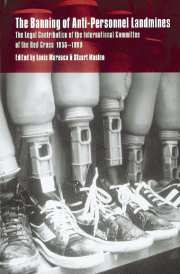 The Banning of Anti-Personnel Landmines
The Banning of Anti-Personnel Landmines Book contents
- Frontmatter
- Contents
- Foreword by Cornelio Sommaruga, President, International Committee of the Red Cross
- Foreword by Ambassador Jacob S. Selebi, South Africa
- Foreword by Ambassador Johan Molander, Sweden
- Introduction
- PART 1 FROM PRINCIPLES TO RULES: REGULATING MINES UP TO THE 1980 CONVENTION ON CERTAIN CONVENTIONAL WEAPONS
- 1 Historical background: the international law governing weapons
- 2 The ICRC's draft rules to protect civilian populations 1955–1956
- 3 Expert contributions to the Diplomatic Conference on the Reaffirmation and Development of International Humanitarian Law Applicable in Armed Conflicts 1973–1977
- 4 The United Nations Convention on Prohibitions or Restrictions on the Use of Certain Conventional Weapons Which May be Deemed to be Excessively Injurious or to Have Indiscriminate Effects, adopted 10 October 1980
- PART 2 THE REVIEW CONFERENCE OF THE 1980 CONVENTION ON CERTAIN CONVENTIONAL WEAPONS: AN INITIAL RESPONSE TO THE LANDMINE CRISIS
- PART 3 THE OTTAWA PROCESS FROM REGIONAL INITIATIVES TO AN INTERNATIONAL PROHIBITION OF ANTI-PERSONNEL MINES
- Index
2 - The ICRC's draft rules to protect civilian populations 1955–1956
from PART 1 - FROM PRINCIPLES TO RULES: REGULATING MINES UP TO THE 1980 CONVENTION ON CERTAIN CONVENTIONAL WEAPONS
Published online by Cambridge University Press: 03 December 2009
- Frontmatter
- Contents
- Foreword by Cornelio Sommaruga, President, International Committee of the Red Cross
- Foreword by Ambassador Jacob S. Selebi, South Africa
- Foreword by Ambassador Johan Molander, Sweden
- Introduction
- PART 1 FROM PRINCIPLES TO RULES: REGULATING MINES UP TO THE 1980 CONVENTION ON CERTAIN CONVENTIONAL WEAPONS
- 1 Historical background: the international law governing weapons
- 2 The ICRC's draft rules to protect civilian populations 1955–1956
- 3 Expert contributions to the Diplomatic Conference on the Reaffirmation and Development of International Humanitarian Law Applicable in Armed Conflicts 1973–1977
- 4 The United Nations Convention on Prohibitions or Restrictions on the Use of Certain Conventional Weapons Which May be Deemed to be Excessively Injurious or to Have Indiscriminate Effects, adopted 10 October 1980
- PART 2 THE REVIEW CONFERENCE OF THE 1980 CONVENTION ON CERTAIN CONVENTIONAL WEAPONS: AN INITIAL RESPONSE TO THE LANDMINE CRISIS
- PART 3 THE OTTAWA PROCESS FROM REGIONAL INITIATIVES TO AN INTERNATIONAL PROHIBITION OF ANTI-PERSONNEL MINES
- Index
Summary
As early as the 1950s the ICRC identified the landmine as a weapon of special concern. One of the first efforts to limit the consequences of landmines was the ICRC's Draft Rules for the Limitation of the Dangers Incurred by the Civilian Population in Time of War published in 1956 (referred to below as 1956 Draft Rules). These rules were issued in response to developments in armaments and military doctrine, and the widespread injury and damage to civilian populations during the Second World War. As international humanitarian law was founded on the fundamental distinction between combatants and non-combatants, the ICRC was concerned that the proliferation of so-called ‘blind’ weapons and methods of warfare, which were unable or failed to take this distinction into account, would severely undermine the protection it afforded. The 1956 Draft Rules sought to affirm and supplement many of the principles found in earlier international humanitarian law treaties.
Work on the draft rules began in April 1954 with a meeting of outside experts. Based on the results of this meeting, the ICRC prepared a first draft document entitled ‘Draft Rules for the Protection of the Civilian Population from the Dangers of Indiscriminate Warfare’ (referred to below as the ‘1955 draft’) which it then submitted to National Red and Red Crescent Societies and other individuals for comment. While this draft contained regulations on means and methods of warfare, there was no specific rule on the use of landmines. The ICRC nevertheless recognized the danger that these weapons posed to civilian populations. While Article 10(3) of the 1955 draft covers the use of ‘delay-action’ projectiles, the ICRC in its commentary discussed the broader category of ‘delay-action’ weapons, including both submarine mines and landmines. Article 10(3) and the relevant parts of the ICRC commentary are reproduced below.
- Type
- Chapter
- Information
- The Banning of Anti-Personnel LandminesThe Legal Contribution of the International Committee of the Red Cross 1955–1999, pp. 15 - 18Publisher: Cambridge University PressPrint publication year: 2000
- 1
- Cited by
